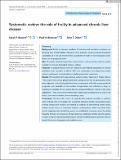Files in this item
Systematic review : the role of frailty in advanced chronic liver disease
Item metadata
| dc.contributor.author | Bowers, Sarah P | |
| dc.contributor.author | Brennan, Paul N | |
| dc.contributor.author | Dillon, John F | |
| dc.date.accessioned | 2022-12-15T12:30:07Z | |
| dc.date.available | 2022-12-15T12:30:07Z | |
| dc.date.issued | 2023-02-01 | |
| dc.identifier | 282581389 | |
| dc.identifier | 9226fe68-ca9a-44c7-b734-68408cf097fe | |
| dc.identifier | 36433627 | |
| dc.identifier | 85143410783 | |
| dc.identifier.citation | Bowers , S P , Brennan , P N & Dillon , J F 2023 , ' Systematic review : the role of frailty in advanced chronic liver disease ' , Alimentary Pharmacology & Therapeutics , vol. 57 , no. 3 , pp. 280-289 . https://doi.org/10.1111/apt.17324 | en |
| dc.identifier.issn | 0269-2813 | |
| dc.identifier.uri | https://hdl.handle.net/10023/26602 | |
| dc.description.abstract | BACKGROUND Frailty is a known predictor of outcome and mortality in patients undergoing liver transplantation. However, most patients remain unsuitable transplant candidates. It is not yet known if the assessment of frailty in non-transplant candidates can aid prognostication. AIM To collate and interrogate the various frailty tools presently used to predict mortality in the non-transplant cirrhosis setting. METHODS A comprehensive review of MEDLINE and EMBASE databases for articles published from inception to March 2022 was undertaken, excluding those where patients underwent transplantation or had hepatocellular carcinoma. RESULTS We identified 12 observational cohort studies, featuring 9 frailty indices. These were from various global healthcare settings and of fair or good quality. Most were objective tools utilising clinician-based assessments. All frailty scores predicted prognosis, with variability in the method of application, and utilisation in long- or short-term mortality. Three studies directly compared different indices in the same population. There was some evidence that simple tools could perform as well, if not better, than more complex, time-consuming scores. CONCLUSIONS Various frailty tools can reproducibly evaluate mortality in patients with cirrhosis who are ineligible for transplant. However, further prospective head-to-head comparative studies are needed. In addition to determining model utility, studies should focus on important relative considerations which may limit widespread implementation including, ease of use and limited resources, given the global disparity of liver care provision. These tools may positively identify specific patient cohorts at risk of impending deterioration, thereby stratifying those patients likely to benefit from early integration with palliative care. | |
| dc.format.extent | 10 | |
| dc.format.extent | 906623 | |
| dc.language.iso | eng | |
| dc.relation.ispartof | Alimentary Pharmacology & Therapeutics | en |
| dc.subject | RC Internal medicine | en |
| dc.subject | MCC | en |
| dc.subject.lcc | RC | en |
| dc.title | Systematic review : the role of frailty in advanced chronic liver disease | en |
| dc.type | Journal item | en |
| dc.contributor.institution | University of St Andrews. Population and Behavioural Science Division | en |
| dc.contributor.institution | University of St Andrews. School of Medicine | en |
| dc.identifier.doi | https://doi.org/10.1111/apt.17324 | |
| dc.description.status | Peer reviewed | en |
This item appears in the following Collection(s)
Items in the St Andrews Research Repository are protected by copyright, with all rights reserved, unless otherwise indicated.

